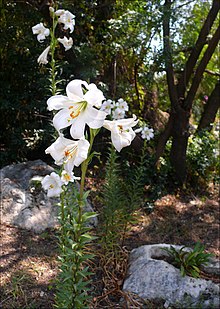Lilium candidum
| Lilium candidum | |
|---|---|
 |
|
| Scientific classification | |
| Kingdom: | Plantae |
| (unranked): | Angiosperms |
| (unranked): | Monocots |
| Order: | Liliales |
| Family: | Liliaceae |
| Genus: | Lilium |
| Species: | L. candidum |
| Binomial name | |
|
Lilium candidum L. |
|
| Synonyms | |
|
|
Lilium candidum, the Madonna lily, is a plant in the true lily family. It is native to Balkans and the Middle East, and naturalized in other parts of Europe (France, Italy, Ukraine, etc.) as well as in North Africa, the Canary Islands, Mexico, and other places. It forms bulbs at ground level, and unlike other lilies, has a basal rosette of leaves through the winter, which die back in summer. A leafy flower stem, typically up to 1.2 metres (3 ft 11 in) high, sometimes up to 2 metres (6 ft 7 in) high, emerges in late spring and bears sweetly and headily fragrant flowers in summer. Flowers are white, flushed yellow at the base.
It has long been cultivated, but is susceptible to virus diseases of lilies, and to Botrytis fungus. One possible way to avoid problems with viruses is to grow plants raised from seed.
The Madonna lily is often described as being the basis of the fleur de lis, though the shape of this stylised flower more strongly resembles that of a flag iris.
Madonna lilies are depicted in a fresco at the Minoan palace of Knossos.
The Madonna Lily symbolizes purity for Roman Catholics. Medieval depictions of the Blessed Virgin Mary often show her holding these flowers.
There are translations of the Bible that identify the Hebrew word Shoshannah as 'lily' in Song of Songs ("As the lily among thorns, so is my love among the daughters." Song of Songs 2:2 (KJV)), not as a rose as is customary to translate. For example, Abraham ibn Ezra describes it as a white flower, which has a good fragrance, and has a six-petal flower and six stamens. But its identity is uncertain, because it does not fit with the description as "the lily of the valleys", because mostly it grows in the mountains.
...
Wikipedia
